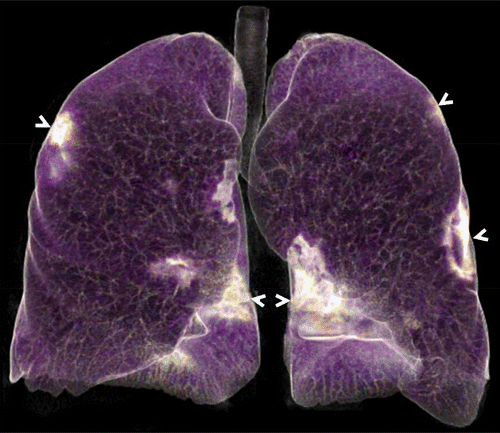3D CT of Patient Positive for COVID-19 Pneumonia
CT scan and video reveal peripheral, multilobar areas of ground-glass opacity.

Researchers from Pamukkale University Medical School is Turkey have released pictures and a 3D reconstruction video from a 38-year-old COVID-19 patient. They published these results in a March 31 article in Radiology.
The patient, who presented with symptoms, including fever, shortness-of-breath, dry cough, and loss of the sense of smell, that had lasted for three days. He also reported pleuritic chest pain that had lasted for several hours. Although most routine lab values were normal, a lung exam with a stethoscope did reveal a crackling sound.
Upon undergoing an unenhanced chest CT for a preliminary pneumonia diagnosis, the patient’s images revealed peripheral, multilobar areas of ground-glass opacity. This sign suggested a new diagnosis of COVID-19 pneumonia. A subsequent nasopharyngeal swab with real-time polymerase chain reaction (RT-PCR) was also COVID-19-positive, confirming the diagnosis.
The patient was hospitalized and received oxygen inhalation, hydroxycholorquine, oseltamivir, and lopinavir/ritonavir. On day 6, his fever returned to normal, and his clinical symptoms began to show improvement.
Common CT features, according to the researchers, are peripheral, bilateral, multilobar, and basal pre-dominant distributed consolidation and/or ground-glass opacities.
Study with CT Data Suggests Women with PE Have More Than Triple the One-Year Mortality Rate than Men
April 3rd 2025After a multivariable assessment including age and comorbidities, women with pulmonary embolism (PE) had a 48 percent higher risk of one-year mortality than men with PE, according to a new study involving over 33,000 patients.
The Reading Room: Racial and Ethnic Minorities, Cancer Screenings, and COVID-19
November 3rd 2020In this podcast episode, Dr. Shalom Kalnicki, from Montefiore and Albert Einstein College of Medicine, discusses the disparities minority patients face with cancer screenings and what can be done to increase access during the pandemic.
Predicting Diabetes on CT Scans: What New Research Reveals with Pancreatic Imaging Biomarkers
March 25th 2025Attenuation-based biomarkers on computed tomography (CT) scans demonstrated a 93 percent interclass correlation coefficient (ICC) agreement across three pancreatic segmentation algorithms for predicting diabetes, according to a study involving over 9,700 patients.
Can Photon-Counting CT be an Alternative to MRI for Assessing Liver Fat Fraction?
March 21st 2025Photon-counting CT fat fraction evaluation offered a maximum sensitivity of 81 percent for detecting steatosis and had a 91 percent ICC agreement with MRI proton density fat fraction assessment, according to new prospective research.